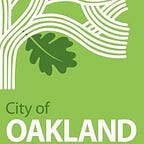Not Too Fast, Not Too Slow and Now Safer: Telegraph Complete Streets
How the City of Oakland is Working to Make Telegraph Avenue Safer
We’re proud that Telegraph Avenue is one of “America’s Best New Bike Lanes of 2016” (People for Bikes) and nominated for “Best Street Transformations of 2016” (Streetsblog). The Telegraph Avenue changes are part of a “complete streets” project that includes a road diet to calm traffic, parking-protected bike lanes to make cyclists safer, and pedestrian improvements to make the strip more walkable. Apart from those honors, how has the corridor been performing since these changes?
We decided to find out.
We looked at the usual things — traffic collisions, traffic speeds, and traffic volumes. But we also wanted a fuller picture. What have the changes meant to commuters, residents, and businesses? We came up with a set of metrics to measure the project’s impact, based on the project goals of safety, the variety of use, and neighborhood vitality. Additionally, we studied user satisfaction, retail activity, and changes in how people are using the corridor.
Not too fast, not too slow, and now safer
If you’re a person walking down the street and get hit by a car going 20 miles per hour, studies show your odds of surviving the collision are decent: nine out of ten pedestrians survive the crash. But if you’re hit by a car going 30 mph, there’s a 50–50 chance the collision will kill you. At 40 mph, only 1 in 10 pedestrians survive. This is why we focused on speeding in Oakland — it’s directly related to our goals to keep Oaklanders safe and eliminate collision deaths in the Town.
Reduced speeding was one of the benefits we hoped to create on Telegraph, and we’re seeing positive trends. Before the project, we observed up to 64% of vehicles driving over the speed limit on Telegraph. Since we implemented the changes (detailed in the report), we’ve seen as much as a 45% decrease in speeding. Is this a common trend citywide? We don’t think so: outside the project area but still on Telegraph, we observed little-to-no change in speeding. So we’re excited by these promising trends in the Telegraph project area.
While we’re seeing a decrease in the number of vehicles that are speeding, we’re still not seeing a major drop in the the median speed of all cars on Telegraph. In fact, we observed only about a two mile per hour decrease in the median speed. More importantly, that median speed is now the same as the speed limit — 25 mph. This means that even with the change from two travel lanes to one, traffic flows more consistently on Telegraph. This change still delivers drivers from point A to point B in the same amount of time, but now more consistently at a safe speed.
Another benefit of the reduction in travel lanes is an increase in drivers yielding to pedestrians. Before the project, we observed just 20% of vehicles stopping for pedestrians who’ve entered the crosswalk. Meaning that on average, you’d see 4–5 cars pass by before one would stop). Now we’re observing up to 67% yield rates at some crosswalks. So, fewer cars failing to yield per pedestrian (now one car or fewer). This change shows us that pedestrians are safer using the corridor.
Just as important, people walking on Telegraph report feeling safer. Of those pedestrians who responded to our street survey, 63% felt that the overall safety of walking on Telegraph has increased. 33% felt it stayed the same. We also asked about crossing Telegraph, because now pedestrians have only two lanes of moving traffic to cross, rather than four. Responses showed that pedestrians on Telegraph appreciate the changes. 55% said the safety of crossing at intersections without signals has increased. 30% said it stayed the same.
It’s too early to carve these results in stone, but they show encouraging trends for improved safety. The results provide context for the 40% reduction in collisions for all modes of travel, and the 100% decrease in pedestrian collisions. For our Telegraph Complete Streets team, these are the most important trends of all.
